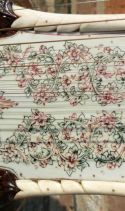Photo report of a Kanailal & Brother surbahar kuti repair. 
 The main kutis of this surbahar are very specific. The surface is smooth and only cut with a saw. Original Kanailal replacement kutis are hard to find. When it is broken, repair is the most obvious solution. In this case it affects a cikari kuti. Note the peculiar position on the neck: it is mounted between the first and second tarav kuti.
The main kutis of this surbahar are very specific. The surface is smooth and only cut with a saw. Original Kanailal replacement kutis are hard to find. When it is broken, repair is the most obvious solution. In this case it affects a cikari kuti. Note the peculiar position on the neck: it is mounted between the first and second tarav kuti.
Kutis are made out of sheesham (sissam) wood. This is a variety of Indian rosewood (Dalbergia sisso) which grows in the Himalayan foothills to Central and South India. Surbahar kutis are rather long. I used a 18cms long piece for this work.

2. Cut the ball with a saw, sand the surface smoothly and mark the center precisely.

3. Drill a hole exactly in the center. (8mm diameter)


5. Make one end of the piece of wood square as well (8x8mm) and make it fit exactly into the ball.

6. Apply wood glue and lock it into a clamp. Give sufficient time to completely dry out. (24hrs min.)


8. Finish the joint and make the kuti fit nicely into the instruments neck.

9. Apply some new lacquer (Shellac) over the joint and fix the original deco pin on top.

See more kuti repair here.



























